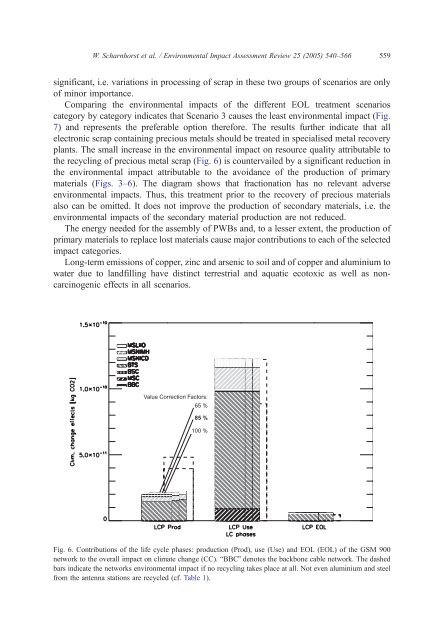The end of life treatment of second generation mobile phone ... - Empa
The end of life treatment of second generation mobile phone ... - Empa
The end of life treatment of second generation mobile phone ... - Empa
You also want an ePaper? Increase the reach of your titles
YUMPU automatically turns print PDFs into web optimized ePapers that Google loves.
W. Scharnhorst et al. / Environmental Impact Assessment Review 25 (2005) 540–566 559significant, i.e. variations in processing <strong>of</strong> scrap in these two groups <strong>of</strong> scenarios are only<strong>of</strong> minor importance.Comparing the environmental impacts <strong>of</strong> the different EOL <strong>treatment</strong> scenarioscategory by category indicates that Scenario 3 causes the least environmental impact (Fig.7) and represents the preferable option therefore. <strong>The</strong> results further indicate that allelectronic scrap containing precious metals should be treated in specialised metal recoveryplants. <strong>The</strong> small increase in the environmental impact on resource quality attributable tothe recycling <strong>of</strong> precious metal scrap (Fig. 6) is countervailed by a significant reduction inthe environmental impact attributable to the avoidance <strong>of</strong> the production <strong>of</strong> primarymaterials (Figs. 3–6). <strong>The</strong> diagram shows that fractionation has no relevant adverseenvironmental impacts. Thus, this <strong>treatment</strong> prior to the recovery <strong>of</strong> precious materialsalso can be omitted. It does not improve the production <strong>of</strong> <strong>second</strong>ary materials, i.e. theenvironmental impacts <strong>of</strong> the <strong>second</strong>ary material production are not reduced.<strong>The</strong> energy needed for the assembly <strong>of</strong> PWBs and, to a lesser extent, the production <strong>of</strong>primary materials to replace lost materials cause major contributions to each <strong>of</strong> the selectedimpact categories.Long-term emissions <strong>of</strong> copper, zinc and arsenic to soil and <strong>of</strong> copper and aluminium towater due to landfilling have distinct terrestrial and aquatic ecotoxic as well as noncarcinogeniceffects in all scenarios.Value Correction Factors:65 %85 %100 %Fig. 6. Contributions <strong>of</strong> the <strong>life</strong> cycle phases: production (Prod), use (Use) and EOL (EOL) <strong>of</strong> the GSM 900network to the overall impact on climate change (CC). bBBCQ denotes the backbone cable network. <strong>The</strong> dashedbars indicate the networks environmental impact if no recycling takes place at all. Not even aluminium and steelfrom the antenna stations are recycled (cf. Table 1).
















